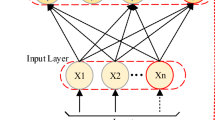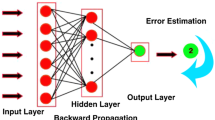Abstract
Predictive models have been widely used in different engineering fields, as well as in petroleum engineering. Due to the development of high-performance computer systems, the accuracy and complexity of predictive models have been increased significantly. One of the common methods for prediction is artificial neural network (ANN). ANN models in combination with optimization algorithms provide a powerful and fast tool for the prediction and optimization of processes which take a large amount of time if they are simulated using common simulation technics. In the present paper, to predict penetration rate during drilling process, several ANN models were developed based on the data obtained from drilling of a gas well located in south of Iran. Regarding the R2 and RMSE values of the developed models, the best model was selected for prediction of penetration rate. In the next step, artificial bee colony algorithm was used for optimization of the parameters which are effective on rate of penetration (ROP). Results showed that the model is accurate enough for being used in the prediction and optimization of ROP in drilling operations.





Similar content being viewed by others
References
Zhao Y, Yang H, Chen Z, Chen X, Huang L, Liu S (2018) Effects of jointed rock mass and mixed ground conditions on the cutting efficiency and cutter wear of tunnel boring machine. Rock Mech Rock Eng. https://doi.org/10.1007/s00603-018-1667-y
Yang HQ, Li Z, Jie TQ, Zhang ZQ (2018) Effects of joints on the cutting behavior of disc cutter running on the jointed rock mass. Tunn Undergr Space Technol 81:112–120
Maurer WC (1962) The “perfect-cleaning” theory of rotary drilling. J Pet Technol 14(11):1–270
Galle EM, Woods HB (1963) Best constant weight and rotary speed for rotary rock bits. In: Drilling and production practice. American Petroleum Institute, Washington, DC
Mechem OE, Fullerton HB Jr (1965) Computers invade the rig floor. Oil Gas J 14
Bourgoyne AT Jr, Young FS Jr (1974) A multiple regression approach to optimal drilling and abnormal pressure detection. Soc Pet Eng J 14(04):371–384
Tansev E (1975) A heuristic approach to drilling optimization. In Fall meeting of the society of petroleum engineers of AIME. Society of Petroleum Engineers
Al-Betairi EA, Moussa MM, Al-Otaibi S (1988) Multiple regression approach to optimize drilling operations in the Arabian Gulf area. SPE Drill Eng 3(01):83–88
Maidla EE, Ohara S (1991) Field verification of drilling models and computerized selection of drill bit, WOB, and drillstring rotation. SPE Drill Eng 6(03):189–195
Hemphill T, Clark RK (1994) The effects of pdc bit selection and mud chemistry on drilling rates in shale. SPE Drill Complet 9(03):176–184
Fear MJ (1999) How to improve rate of penetration in field operations. SPE Drill Complet 14(01):42–49
Ritto TG, Soize C, Sampaio R (2010) Robust optimization of the rate of penetration of a drill-string using a stochastic nonlinear dynamical model. Comput Mech 45(5):415–427
Alum MA, Egbon F (2011) Semi-analytical models on the effect of drilling fluid properties on rate of penetration (ROP). In: Nigeria annual international conference and exhibition. Society of Petroleum Engineers
Yi P, Kumar A, Samuel R (2015) Realtime rate of penetration optimization using the shuffled frog leaping algorithm. J Energy Res Technol 137(3):32902
Hankins D, Salehi S, Karbalaei Saleh F (2015) An integrated approach for drilling optimization using advanced drilling optimizer. J Pet Eng 2015:281276
Asgharzadeh Shishavan R, Hubbell C, Perez H, Hedengren J, Pixton D (2015) Combined rate of penetration and pressure regulation for drilling optimization by use of high-speed telemetry. SPE Drill Complet 30(01):17–26
Wang Y, Salehi S (2015) Application of real-time field data to optimize drilling hydraulics using neural network approach. J Energy Res Technol 137(6):62903
Koopialipoor M, Armaghani DJ, Hedayat A, Marto A, Gordan B (2018) Applying various hybrid intelligent systems to evaluate and predict slope stability under static and dynamic conditions. Soft Comput. https://doi.org/10.1007/s00500-018-3253-3
Koopialipoor M, Armaghani DJ, Haghighi M, Ghaleini EN (2017) A neuro-genetic predictive model to approximate overbreak induced by drilling and blasting operation in tunnels. Bull Eng Geol Environ. https://doi.org/10.1007/s10064-017-1116-2
Hasanipanah M, Armaghani DJ, Amnieh HB, Koopialipoor M, Arab H (2019) A risk-based technique to analyze flyrock results through rock engineering system. Geotech Geol Eng 36(4):2247–2260
Koopialipoor M, Nikouei SS, Marto A, Fahimifar A, Armaghani DJ, Mohamad ET (2018) Predicting tunnel boring machine performance through a new model based on the group method of data handling. Bull Eng Geol Environ 1–15
Shariat M, Shariati M, Madadi A, Wakil K (2018) Computational Lagrangian Multiplier Method by using for optimization and sensitivity analysis of rectangular reinforced concrete beams. Steel Compos Struct 29(2):243–256
Toghroli A, Mohammadhassani M, Suhatril M, Shariati M, Ibrahim Z (2014) Prediction of shear capacity of channel shear connectors using the ANFIS model. Steel Compos Struct 17(5):623–639
Armaghani DJ, Hasanipanah M, Mahdiyar A, Majid MZA, Amnieh HB, Tahir MMD et al (2016) Airblast prediction through a hybrid genetic algorithm-ANN model. Neural Comput Appl. https://doi.org/10.1007/s00521-016-2598-8
Hasanipanah M, Noorian-Bidgoli M, Armaghani DJ, Khamesi H (2016) Feasibility of PSO-ANN model for predicting surface settlement caused by tunneling. Eng Comput. https://doi.org/10.1007/s00366-016-0447-0
Toghroli A, Suhatril M, Ibrahim Z, Safa M, Shariati M, Shamshirband S (2016) Potential of soft computing approach for evaluating the factors affecting the capacity of steel–concrete composite beam. J Intell Manuf 1–9
Armaghani DJ, Mohamad ET, Momeni E, Monjezi M, Narayanasamy MS (2016) Prediction of the strength and elasticity modulus of granite through an expert artificial neural network. Arab J Geosci 9(1):48
Armaghani DJ, Hajihassani M, Sohaei H, Mohamad ET, Marto A, Motaghedi H, Moghaddam MR (2015) Neuro-fuzzy technique to predict air-overpressure induced by blasting. Arab J Geosci 8(12):10937–10950. https://doi.org/10.1007/s12517-015-1984-3
Armaghani DJ, Mohamad ET, Narayanasamy MS, Narita N, Yagiz S (2017) Development of hybrid intelligent models for predicting TBM penetration rate in hard rock condition. Tunn Undergr Space Technol 63:29–43. https://doi.org/10.1016/j.tust.2016.12.009
Mosallanezhad M, Moayedi H (2017) Developing hybrid artificial neural network model for predicting uplift resistance of screw piles. Arab J Geosci 10(22):479
Moayedi H, Jahed Armaghani D (2017) Optimizing an ANN model with ICA for estimating bearing capacity of driven pile in cohesionless soil. Eng Comput. https://doi.org/10.1007/s00366-017-0545-7
Moayedi H, Rezaei A (2017) An artificial neural network approach for under-reamed piles subjected to uplift forces in dry sand. Neural Comput Appl 1–10
Tonnizam Mohamad E, Jahed Armaghani D, Hasanipanah M, Murlidhar BR, Alel MNA (2016) Estimation of air-overpressure produced by blasting operation through a neuro-genetic technique. Environ Earth Sci. https://doi.org/10.1007/s12665-015-4983-5
Hasanipanah M, Jahed Armaghani D, Khamesi H, Amnieh BH, Ghoraba S (2016) Several non-linear models in estimating air-overpressure resulting from mine blasting. Eng Comput. https://doi.org/10.1007/s00366-015-0425-y
McCulloch WS, Pitts W (1943) A logical calculus of the ideas immanent in nervous activity. Bull Math Biophys 5(4):115–133
Garrett JH (1994) Where and why artificial neural networks are applicable in civil engineering. J Comput Civ Eng 8(2):129–130
Fausett L, Fausett L (1994) Fundamentals of neural networks: architectures, algorithms, and applications. Prentice-Hall, Upper Saddle River
Mansouri I, Shariati M, Safa M, Ibrahim Z, Tahir MM, Petković D (2017) Analysis of influential factors for predicting the shear strength of a V-shaped angle shear connector in composite beams using an adaptive neuro-fuzzy technique. J Intell Manuf 1–11
Haykin S, Network N (2004) A comprehensive foundation. Neural Netw 2(2004):41
Koopialipoor M, Fahimifar A, Ghaleini EN, Momenzadeh M, Armaghani DJ (2019) Development of a new hybrid ANN for solving a geotechnical problem related to tunnel boring machine performance. Eng Comput 1–13
Mohammadhassani M, Nezamabadi-Pour H, Suhatril M, Shariati M (2013) Identification of a suitable ANN architecture in predicting strain in tie section of concrete deep beams. Struct Eng Mech 46(6):853–868
Koopialipoor M, Fallah A, Armaghani DJ, Azizi A, Mohamad ET (2018) Three hybrid intelligent models in estimating flyrock distance resulting from blasting. Eng Comput. https://doi.org/10.1007/s00366-018-0596-4
Karaboga D (2005) An idea based on honey bee swarm for numerical optimization. Technical report-tr06, Erciyes University, Engineering Faculty, Computer Engineering Department
Koopialipoor M, Ghaleini EN, Haghighi M, Kanagarajan S, Maarefvand P, Mohamad ET (2018) Overbreak prediction and optimization in tunnel using neural network and bee colony techniques. Eng Comput 1–12
Nozohour-leilabady B, Fazelabdolabadi B (2016) On the application of artificial bee colony (ABC) algorithm for optimization of well placements in fractured reservoirs; efficiency comparison with the particle swarm optimization (PSO) methodology. Petroleum 2(1):79–89
Ahmad A, Razali SFM, Mohamed ZS, El-shafie A (2016) The application of artificial bee colony and gravitational search algorithm in reservoir optimization. Water Resour Manag 30(7):2497–2516
Zhang C, Ouyang D, Ning J (2010) An artificial bee colony approach for clustering. Expert Syst Appl 37(7):4761–4767
Rodriguez FJ, García-Martínez C, Blum C, Lozano M (2012) An artificial bee colony algorithm for the unrelated parallel machines scheduling problem. In: International conference on parallel problem solving from nature. Springer, pp 143–152
Karaboga D, Basturk B (2007) A powerful and efficient algorithm for numerical function optimization: artificial bee colony (ABC) algorithm. J Glob Optim 39(3):459–471
Ghaleini EN, Koopialipoor M, Momenzadeh M, Sarafraz ME, Mohamad ET, Gordan B (2018) A combination of artificial bee colony and neural network for approximating the safety factor of retaining walls. Eng Comput 1–12
Hornik K, Stinchcombe M, White H (1989) Multilayer feedforward networks are universal approximators. Neural Netw 2(5):359–366
Hecht-Nielsen R (1989) Kolmogorov’s mapping neural network existence theorem. In: Proceedings of the international joint conference in neural networks, vol 3, pp 11–14
Ripley BD (1993) Statistical aspects of neural networks. Netw Chaos Stat Probab Aspects 50:40–123
Paola JD (1994) Neural network classification of multispectral imagery. Master Tezi, The University of Arizona, USA
Wang C (1994) A theory of generalization in learning machines with neural applications. PhD thesis, The University of Pennsylvania, USA
Masters T (1993) Practical neural network recipes in C++. Morgan Kaufmann, Burlington
Kanellopoulos I, Wilkinson GG (1997) Strategies and best practice for neural network image classification. Int J Remote Sens 18(4):711–725
Kaastra I, Boyd M (1996) Designing a neural network for forecasting financial and economic time series. Neurocomputing 10(3):215–236
Gordan B, Koopialipoor M, Clementking A, Tootoonchi H, Mohamad ET (2018) Estimating and optimizing safety factors of retaining wall through neural network and bee colony techniques. Eng Comput 1–10
Koopialipoor M, Murlidhar BR, Hedayat A, Armaghani DJ, Gordan B, Mohamad ET (2019) The use of new intelligent techniques in designing retaining walls. Eng Comput 1–12
Safa M, Shariati M, Ibrahim Z, Toghroli A, Baharom SB, Nor NM, Petkovic D (2016) Potential of adaptive neuro fuzzy inference system for evaluating the factors affecting steel–concrete composite beam’s shear strength. Steel Compos Struct 21(3):679–688
Zorlu K, Gokceoglu C, Ocakoglu F, Nefeslioglu HA, Acikalin S (2008) Prediction of uniaxial compressive strength of sandstones using petrography-based models. Eng Geol 96(3):141–158
Acknowledgements
The authors would like to express their sincere appreciation to reviewers because of their valuable comments that increased the quality of our paper. Funding support from Shenzhen Science and Technology Innovation Commission (grant No. JCYJ 20160531192824598, JCYJ 20170811160740635) are greatly appreciated.
Author information
Authors and Affiliations
Corresponding author
Additional information
Publisher’s Note
Springer Nature remains neutral with regard to jurisdictional claims in published maps and institutional affiliations.
Rights and permissions
About this article
Cite this article
Zhao, Y., Noorbakhsh, A., Koopialipoor, M. et al. A new methodology for optimization and prediction of rate of penetration during drilling operations. Engineering with Computers 36, 587–595 (2020). https://doi.org/10.1007/s00366-019-00715-2
Received:
Accepted:
Published:
Issue Date:
DOI: https://doi.org/10.1007/s00366-019-00715-2




